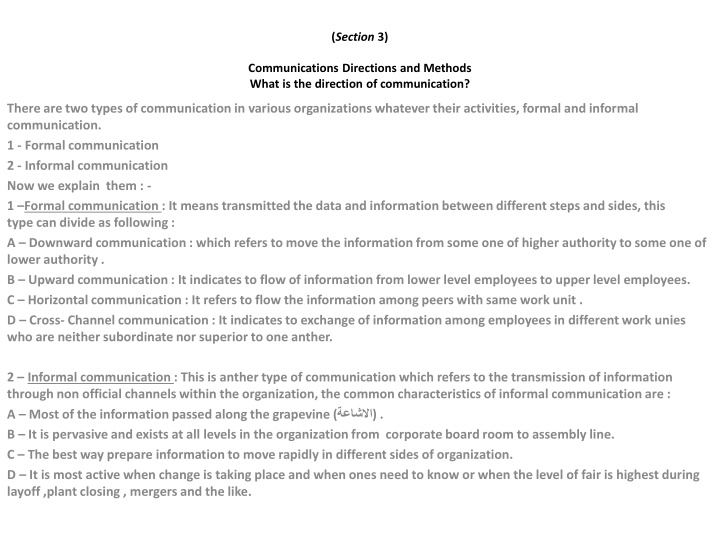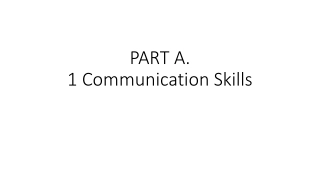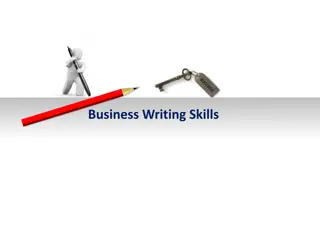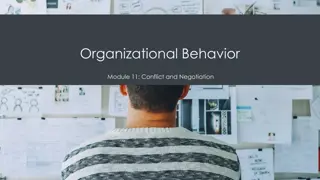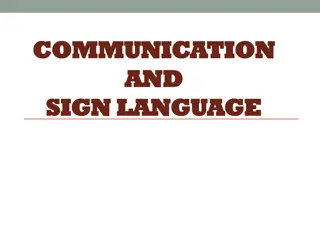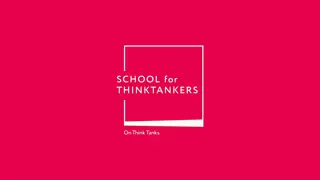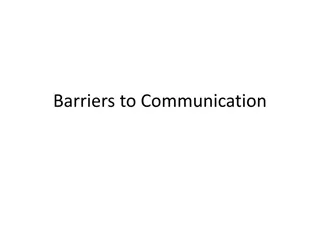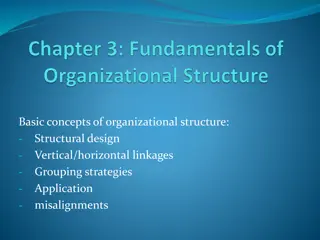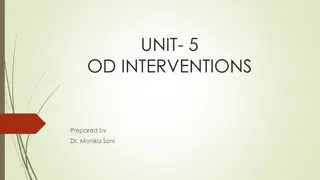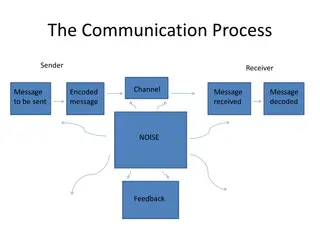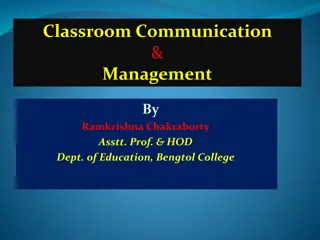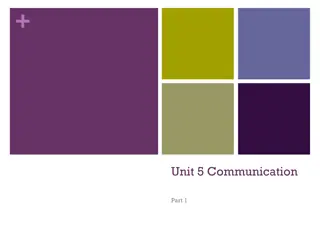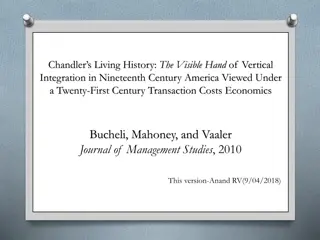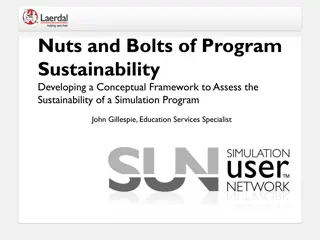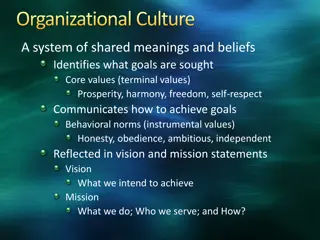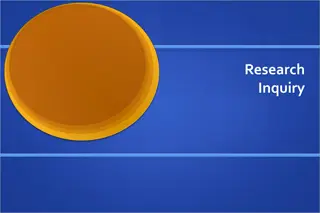Types and Methods of Organizational Communication
Organizational communication encompasses formal and informal channels, including downward, upward, horizontal, and cross-channel formal communication. Methods include written, oral, and nonverbal forms, each serving specific purposes within organizations, from conveying data to facilitating decision-making. Written communication such as email, websites, memorandums, letters, reports, and oral forms like informal conversations and formal speeches are vital for effective workplace communication.
Download Presentation

Please find below an Image/Link to download the presentation.
The content on the website is provided AS IS for your information and personal use only. It may not be sold, licensed, or shared on other websites without obtaining consent from the author.If you encounter any issues during the download, it is possible that the publisher has removed the file from their server.
You are allowed to download the files provided on this website for personal or commercial use, subject to the condition that they are used lawfully. All files are the property of their respective owners.
The content on the website is provided AS IS for your information and personal use only. It may not be sold, licensed, or shared on other websites without obtaining consent from the author.
E N D
Presentation Transcript
(Section 3) Communications Directions and Methods What is the direction of communication? There are two types of communication in various organizations whatever their activities, formal and informal communication. 1 - Formal communication 2 - Informal communication Now we explain them : - 1 Formal communication : It means transmitted the data and information between different steps and sides, this type can divide as following : A Downward communication : which refers to move the information from some one of higher authority to some one of lower authority . B Upward communication : It indicates to flow of information from lower level employees to upper level employees. C Horizontal communication : It refers to flow the information among peers with same work unit . D Cross- Channel communication : It indicates to exchange of information among employees in different work unies who are neither subordinate nor superior to one anther. 2 Informal communication : This is anther type of communication which refers to the transmission of information through non official channels within the organization, the common characteristics of informal communication are : A Most of the information passed along the grapevine ( ) . B It is pervasive and exists at all levels in the organization from corporate board room to assembly line. C The best way prepare information to move rapidly in different sides of organization. D It is most active when change is taking place and when ones need to know or when the level of fair is highest during layoff ,plant closing , mergers and the like.
What are the Methods of communication? There are three primary methods of communication in any organization as following:- 1 - Written communication: - This type always used as formal communication and it includes many means has been used by the organization as a ways to communicate with others such as letters, emails, reports, manuals, forms. 2 - Oral communication: - This type can be considered the most prevalent form communication in organizations. Oral forms of communication are particularly powerful because they include not only speaker's words, but also their changes in tone, pitch, speed and volume. People, ordinary use all of these because to understand oral messages. These types include many forms as, Informal conversations, Group discussions, and Formal speeches. 3 - Nonverbal communication:-It includes all the elements associated with human communication that are not expressed orally or in writing sometimes. Nonverbal communication transmits more meaning than words do. Human elements of nonverbal communication include:- {Facial expression, physical movement, Body language} Further, these elements nonverbal communication involves also environmental elements such as- {Buildings, Office space and Furniture}
(Section 4) Written communication Writing is more difficult than speaking because we have to get our message correct the first time and we do not have the advantage of immediate feedback besides nonverbal clues such as facial expressions help us achieve our objective. In most firms, typing written communication includes the following:- 1 -Email: It is a message transmitted electronically over a computer network. 2 - Web site: It comprises one or more pages of related information that is posted on the World Wide Web (www) and is accessed via the internet. The main page of a website is called its [home page]. 3 - Memorandum: It is a written message sent to someone or working in the same organization. 4 - Letter: It is a written message sent to someone outside the organization. 5 - Report: it is an orderly and objective presentation of information that assists in decision-making and problem solving. 6 - Miscellaneous: This type includes several of written communication include contracts, sales literature, newsletters and bulletin board notices. Writing is crucial to the modern organization because it serves as the major source of documentation. In order to write message achieve their goals, it must be read. The skill of efficient reading that's becoming more important in today for some reason such as: A - Technological society. B - The abundance of widespread computing and word processing capabilities. Business letter: A letter can be defined as a written message sent To somebody by post. While business letter considers a primary means to exchange goods and services freely through the world between various companies. A business companies has been depended on writing letters as a major means of communication to perform their transactions.
The business transactions undertaken by the several of firms, whether they are state owned or privately owned are conducted by means of letters. If both writer and typist keep in mind the following point's aid to a good letter:- 1 - Stationery should be of high quality paper. 2 - Typing should be accurate 3 - The language of the letter should be clear, Concise and grammatically correct. 4 - The writer always keeping in mind the reader's reaction. It has often been said that an attractive letter should look like asymmetrically framed picture with even margins working as a frame for the typed line that are balanced under the letter- head. Importance and Function of Letter writing: We can determine the importance of letters, writing as follows:- 1 -It is preferable and desirable more than oral communication because it leaves a record for future reference .In other words, it considers as documentations. 2 -It is aided to complete most company's functions because firms write letters to customers, suppliers, agencies, employees, government offices. Banks and many other establishments make inquiries to sell goods and collecting payments. 3 -Foreign trade depends on letter writing to accomplish import and export transactions in every trading. An organization that deals with large-scale importation of consumer goods and capital goods have constituted specialized department to contact suppliers and follow up the import procedures.
We can determine the functions of business letters as following: To give information to the reader because the achievement of the firm 's objectives depended on the quality and quantity of information which supplied for them. To get information from consumers involves their opinions' about productions and services which provided by their companies. In other word business, letters used as feedback channel and attempt to construct a nice image about it. To build good will that refers to a feeling of confidence in accompany that makes a customer trade with it rather than with another. (Section 5) Quality of Writing An effective letter refers to writing that produces the desired results, or the message, which is influencing the reader's attitudes and actions. There is a set of variables effect on the quality of business letter to be active. These variables divided into two groups. First group: - Benefit variables that it involves many positive points must use to obtain an effective letter such as: 1 - Write clearly; This is done by making the message accurate and complete further using familiar words when it contains suitable information for the reader,( no more and no less) beside using language that the sender and receiver understand it. 2 - Prefer short and simple words because they are more likely to be missed and less likely to be missed and less likely to distract the reader. Business writers, in fact, write directly and clearly, when we want to write as much information in their message using short and simple words. 3 - Write with Vigor:- This is important because: A - Vigor's writing holds their readers' interest. But if they are not interested enough to read your message, as a result, your writing cannot possibly achieve its objective B - A second reason for writing with vigor has to do with language itself. Therefore vigor's writing tends to lend vigor to the ideas presented. 4 - Use specific and concrete language:-It is important and possible, choosing specific words that have a definite, unambiguous meaning, likewise choose concrete words that bring a definite picture to the reader's mind .
5- Write concisely:- The revolution of information has created more paperwork, giving business people access to more data. .This lead to have and obtain more data to analyze but not being able to read any faster or having more time in which to do. 6 - Prefers positive language:-The words that create positive image are more likely to help people to achieve their goals than are negative words . Positive language also builds good will for sender and your organization and often gives more information than negative language. Second group: Bad variables that it includes as we mention in previous pages, many negative points must avoid it to gain effective letters. 1 - Avoid the dangling expression:- which it refers to any part of a sentence that does not logically fit with other sentences in a letter. The two most common types of dangling expression are misplaced modifiers and unclear with previous expressions. 2 - Avoid jargon words and expressions:- Jargon vocabulary used within a special group, jargon some time is appropriate, but in some time is unsuitable, it is important to notice that jargon perhaps appropriate in same field work but inappropriate in a different field of work. 3 - Avoid clich s, slang and buzz words: - A clich d is an expression that has become monotonous through over use and also avoid slang in business writing for several reasons such as:- A -It is informal writing while much business writing used formal words. B - It is short-lived. A slang phrase used today may not be in use in the future. C - It may not be familiar. Abuzz word is an important sounding express used mainly to impress other people . Abuzz words usually used by government officials and high - ranking business people. 4 - Avoid redundancy:- A redundancy refers to the unnecessary repetition of an idea that has already been expressed or intimated.
